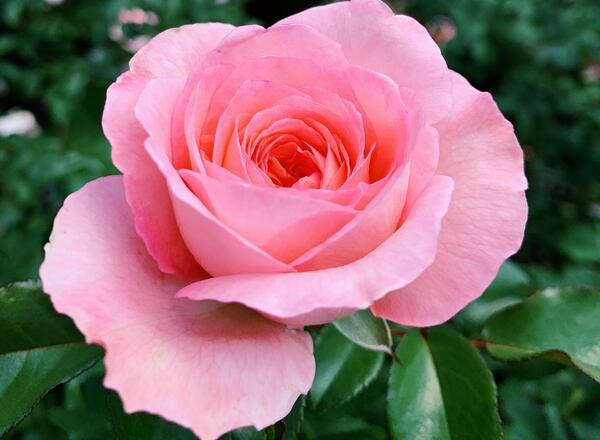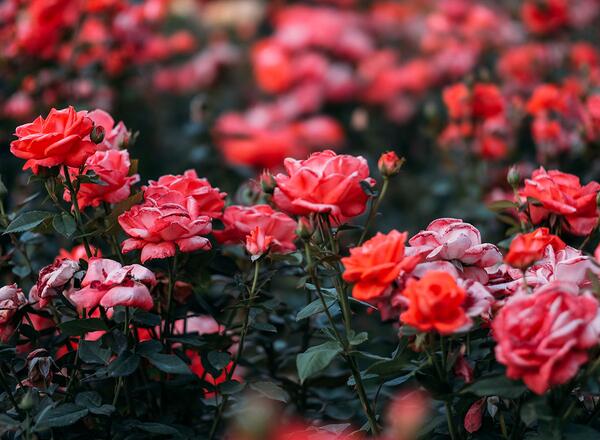The rose is, according to fossil evidence, 35 million years old. In nature, the genus Rosa has some 150 species spread throughout the Northern Hemisphere, from Alaska to Mexico and including northern Africa. Garden cultivation of roses began some 5,000 years ago, probably in China.

During the Roman Empire, roses were grown extensively in the Middle East. They were used as confetti at celebrations, for medicinal purposes, and as a source of perfume. Roman nobility established large public rose gardens south of Rome. After the fall of the Roman Empire, roses moved in and out of popularity. During the fifteenth century, the rose was used as a symbol for the factions fighting to control England. The white rose symbolized York, and the red rose symbolized Lancaster, as a result, the conflict became known as the War of the Roses.

Roses were in such high demand during the seventeenth century that royalty considered roses or rose water as legal tender, and they were often used as barter and for payments. Napoleon’s wife Josephine established an extensive collection of roses at Chateau de Malmaison, an estate seven miles west of Paris in the 1800s. This garden became the setting for Pierre Joseph Redoute’s work as a botanical illustrator. In 1824, he completed his watercolor collection Les Roses, which is still considered one of the finest records of botanical illustration.

It wasn’t until the late eighteenth century that cultivated roses were introduced into Europe from China. Most modern-day roses can be traced back to this ancestry. These introductions were repeat bloomers, making them unusual and of great interest to hybridizers, and setting the stage for breeding work with native roses to select for hardiness and a long bloom season. Many of these early efforts by plant breeders are of great interest to today’s gardeners.
Resources
The University of Illinois Extension Master Gardeners Manual served as the resource for this website. That publication was created with the following references:
References
- Austin, David. 2008. The English Rose: Classic Favorites and New Selections. Firefly Books. Tonawanda, NY
- Beales, Peter. 2002. Classic Roses. Random House. New York, NY
- Cairns, Tommy. 2007. Ortho’s All About Roses. Meredith Books. Des Moines, IA
- Christopher, Thomas. 2002. In Search of Lost Roses. University of Chicago Press. Chicago, IL
- Harkness, Philip. 2004. Reliable Roses: Easy to Grow. Roses That Won’t Let You Down. Firefly Books. Tonawanda, NY.
- Harran, David. 1998. Roses for Northern Gardens. Lone Pine Publishing. Auburn, WA.
- Martin, Clair G. 2000. 100 Old Roses for the American Garden. Workman Press. New York, NY. Mattock, Mark. 2002. Roses for the Smaller Garden. Rizzoli Press. New York, NY.
- McCann, Sean. 2006. The Rose for Today: Growing the Beautiful Mini-Flora. American Rose Society. Shreveport, LA.
- Mikolazski, Andrew. 2004. Miniature Roses. Anness Publishing. Lanham, MD.
- Raff, Marilyn. 2006. Shrub Roses: Paradise in Bloom. Johnson Books. Boulder, CO.
- Scanniello, Stephan (ed). 1995. Easy Care Roses: Low Maintenance Charmers. Brooklyn Botanic Garden Handbook #142. Sterling Publications. New York, NY.
- Schneider, Peter. 2009. Right Rose Right Place. Storey Publishing. North Adams, MA.
- Verrier, Suzanne. 1999. Rosa Rugosa. Firefly Books. Tonawanda, NY.
- Young, Marilyn A. and P. Schoor (ed). 2007. Modern Roses 12: The Comprehensive List of Roses in Cultivation or of Historical or Botanical Importance. American Rose Society. Shreveport, LA.
- Zuzek, Kathy, M. Richards, S. McNamara and H. Pellet. 1995. Roses for the North. Minnesota Agricultural Experiment Station. St. Paul, MN
- Combined Rose List. This guide lists all roses available in commerce, with specific catalog sources for each rose. This is perhaps the best way to track down difficult to find roses. Available from Peter Schneider, P. O. Box 677, Mantua, OH 44255.